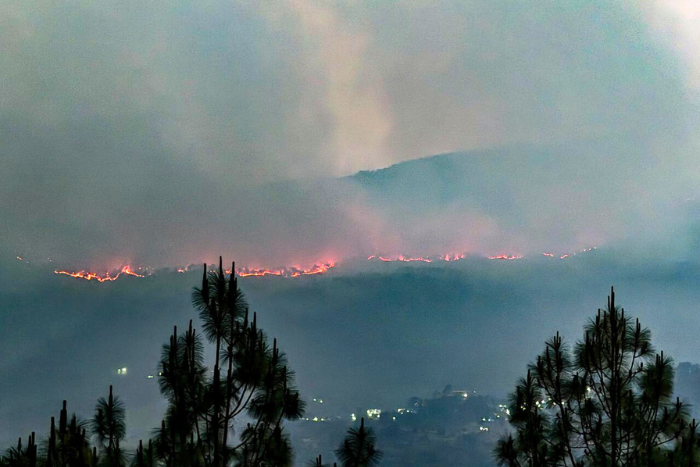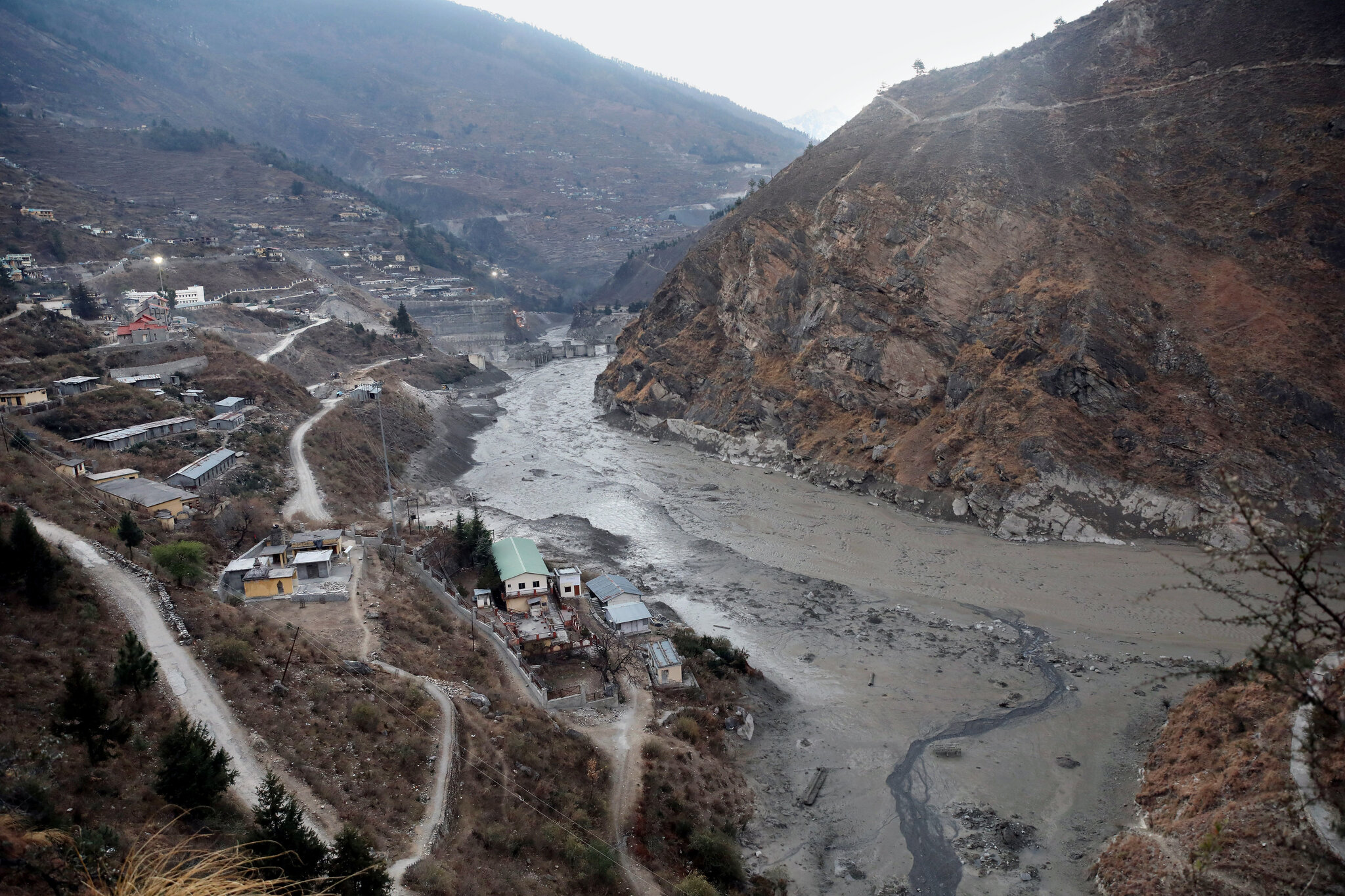Is pine the real ‘villain’ in the Uttarakhand forest fire saga?
Even as the Uttarakhand govt blames the rapidly growing presence of pine for the uncontrolled forest fires in the region, the absence of fire lines, inadequate forest staff, climate-induced dry weather and inadequate rainfall also need to be acknowledged in order to find a sustainable solution to the issue, say experts
By Hridayesh Joshi / Jul 8, 2024

A scene of burning forest in Kumaon region of Uttarakhand. Photo - Jaimitra Singh Bisht
In May this year, visuals of Uttarakhand chief minister Pushkar Singh Dham clearing pine leaves (pirul) appeared in the media. “Dry leaves of Pirul are the biggest cause of forest fires,” the CM said, while announcing the government’s ‘Pirul Lao-Paise Pao’ campaign, aimed at incentivising locals to help the forest department in collecting pine leaves.
This year, amidst a prolonged spell of hot and dry weather, Uttarakhand saw more than 1,200 incidents of forest fires, which claimed the lives of at least 10 people, including some forest guards. One could argue this campaign was the government’s attempt to pivot the blame away from grim ground realities and solely towards these age-old pine trees. While it is true that pine in the Himalayan forests is seen as a major cause for the spread of forest fires— the inflammable leaves and resin cause the fire to spread rapidly and go out of control—there are much deeper issues also at play here. The absence of fire lines— which are strips of open land in a forest that stop a fire from advancing—and inadequate labour to control these fires are two major factors. Climate change also plays a big role in aggravating forest fires. Inadequate winter rain—which provides moisture that stops fires from getting out of control—protracted summers and higher temperatures are also fuelling these fires, experts say. This year, Uttarakhand recorded a rise in winter wildfires. In the past five months, severe fires have occurred even in those forests where there is no pine or very little of it.

But instead of addressing all these issues together, the Uttarakhand government’s decision to “villainise” one species, whose frequency and scale is rising, is a myopic strategy and will prove to be detrimental in the long term, experts say. Pine is just one conifer standing among many other species in the Himalayan slopes. Focusing solely on it shows the government’s incorrect understanding of the larger Himalayan ecosystem and is leading to unsustainable solutions to the forest fire issue, according to experts.
Pine has been an integral part of India’s mountain forests cover since the Himalayas first formed. Experts say in order to curb forest fires, a more holistic approach is needed, which acknowledges the laws of the jungle and tries to address the human factors for the spread of forest fires.
Forest fires are man-made
Almost all forest fires are anthropogenic and caused by human activity. Villagers burn dry grass in the hope of getting better growth of fodder for their cattle. This can sometimes lead to major fires. Leaving a lit cigarette, cooking or a bonfire left burning can also trigger forest fires. Poor waste management also forces locals and authorities to burn garbage to get rid of dry waste, triggering fires.
However it is important to understand not all forest fires are destructive. The sporadic fires contribute to maintaining the health of the ecosystem. They play a vital role in forest ecology by clearing the accumulated weeds and recycling nutrients. These fires also help in seed germination. But climate change is tipping this effect of forest fires from being producing to destructive. It is triggering frequent, uncontrolled and large forest fires that not only destroy biodiversity and precious forest resources, but also increase the danger of flash floods by ruining the top layer of soil.
Officials of the forest research department of Uttarakhand say that these large forest fires have endangered not only the valuable plant species, but also the “rare species of birds (like the native cheer pheasant, kalij pheasant and common rose etc.) whose breeding season coincides with fire season from April to June.” Several hundred species of butterflies critical for biodiversity may be at the “verge of getting endangered” as host plants are getting consumed by forest fires.
How is pine linked to the spread of forest fires?
The spread of forest fire is attributed to pine because of the inflammable dry leaves, which it sheds heavily during and before the fire season. Kamlesh Jeena, a volunteer villager engaged in dousing the forest fire in Kumaon region of Uttarakhand said, “Due to pirul, the fire takes a very dangerous form and spreads rapidly and becomes uncontrollable. It seems as if petrol has been set on fire. There is a risk to our lives in extinguishing it.”
Besides, there is resin that is extracted from pine trees for commercial purposes. To collect resin, marks are made on the trunks of trees from where this sticky liquid seeps out. When there is fire in the jungle, this liquid is inflammable.
Shekhar Pathak, the historian who is studying western and central Himalayan region for the last five decades says, “When the fire reaches up and resin [seeping out of the trunk] catches fire, this burning-lump may blow with the high speed wind and spread the fire in other parts, too. Now we have photographic evidence about this. Therefore it is important to understand the territory of chir-pine to keep the fire in check.”
How pine grew to dominate the Himalayan forests
Pine is a native tree species of India. Contrary to popular belief, it was not introduced by the British, but over the decades it received favourable conditions to grow and dominate in the mountainous landscape. Today, there are as many as 8 native and 21 exotic species of pine in India. It was always beneficial for the government to grow pine for its resin, which is used in turpentine oil, soap, paper, paint and chemical industry. It has been an important revenue-earning source for the government since the colonial period. Even now, the Uttarakhand government earns around ₹200 crore annually from the resin.

Pathak says the British were so aware about the commercial benefits of resin from pine that in the early 19th century they established a small factory unit in Kashipur, Uttarakhand, to exploit its benefits.
“That was perhaps the first enterprise of the British in the Himalayas even before colonising the hills. At that time, East India Company did not have the administrative control over Kumaon, but they had already set their eyes on this resource and launched the commercial initiative,” Pathak said.
The British expanding its railway network in India in the 1850s was a turning point in the ecological history of the Himalayan forests. Within a period of about 60 years, between 1853 and 1910, the network of railways increased from a mere 32 km to more than 51,000 km. An enormous amount of wood was required for railway tracks and coaches. Teak, oak, deodar and sal from these forests were cut for fuelwood and construction purposes. The expansion of railway, therefore, coincided with the growing presence of pine in the Himalayan forests.
GS Rawat, emeritus scientist, Uttarakhand Council for Science & Technology ((UCOST), & formerly dean with Wildlife Institute of India (WII) said, “Exploitation of forests and other resources in India did not stop even after the British left. Sal and deodar usually do not share the habitat with pine. Hence, it may not be correct to say that commercial extraction of sal and deodar during the British period may have led to expansion of pine. But there is no doubt that the mid-elevation broadleaf tree, oak, locally known as baanj (Quercus leucotrichophora) has been the most favoured fuel wood and fodder species for the local people in Uttarakhand. Degradation of oak forests, especially on south-facing slopes, and frequent fires in oak forests could have led to the expansion of pine. Chir Pine is not an ideal species for making railway sleepers as it is less durable and more resinous compared to sal.”
Pine vs oak: More emotions, less science?
Some other researchers have argued that Chir Pine is encroaching into the space of Banj Oak, thus making the forests more fire prone. In the mountainous landscape, in the context of forest fire and ecological balance, the characteristics of needle-leaved Chir Pine are often compared with broad-leaved Banj Oak (quercus) as they grow in a common habitat. It is generally believed that pine makes the surrounding land arid, whereas oak trees hold water and provide moisture to the soil, creating a healhty ecosytem. Several experts working in the Himalayan region for decades told this writer that there are “many misconceptions” about pine and oak and most of the things are said in “emotional outbursts which have no scientific basis.”
Professor Chandra Singh Negi, a zoologist professor in MBPG College, Haldwani, Nainital, who has been researching on Himalayan ecology for over two decades says, “The truth is contrary to popular belief. Pine grows in xeric conditions and oak needs good moisture. If you plant oak in dry conditions it will not grow. Often people say that we will cut down the pine and grow broadleaf species like oak to make the jungles safe (from forest fires), but it won’t be successful.” Pine, on the other hand, adapts well to the lack of moisture and thrives in dry conditions, which have been increasing in the Himalayan region thanks to climate change. Unlike oak, its thin, needle-shaped leaves have less surface area and the tree loses less water. Its conical shape, waxy coating on the leaves and deep roots provide an added advantage.
This study observed a substantial reduction of banj oak forest habitats in the Western Himalayas between 1991 and 2017, while pine forests expanded considerably. Another study found that the Banj Oak forests are declining and Chir Pine is displacing Banj Oak in the Central Himalaya.
Yogesh Gokhale, a biodiversity expert and senior fellow with the New Delhi based The Energy and Resources Institute (TERI) says that the “invasive nature of pine, which is altering the landscape of Himalayan forests, cannot be overlooked.”“There are several species of pine in the Himalayan region, but Chir Pine is certainly an issue. My observation is Chir Pine is altering the forest mosaic of Uttarakhand in a big way. The regeneration of species, particularly the regeneration of Oak, which otherwise should have taken place, is being hampered because of the layer of pine needles,” he said.

But the forest department’s research centre, built amidst dense forests outside Ranikhet in Uttarakhand, has no such warning. “Forest fire does not occur due to pine trees, but because of our carelessness,” is clearly stated on the board outside. It welcomes visitors with information related to pine. Apart from the native Chir Pine, many other exotic species of pine find a mention. “Interesting facts about pine”, include its quality to stop soil erosion in the hills, besides its ability to grow in dry conditions.
All experts agree on one thing—that over the years, favourable conditions were created for the growth and spread of pine. In early 1980s, the Supreme Court of India put a ban on felling of trees above 1,000 m. This ban was lifted in 2023, but pine had a clear advantage over other species during the four decades of the ban. Rawat says that the ban on green felling by the Apex court was with good intentions and it saved large and contiguous patches of forests. However, free grazing in the forests and lopping of fodder trees such as oaks was not checked.
Rawat told Carboncopy, “Excessive lopping of trees and tree saplings was not banned. As a result, regeneration of oaks and other broadleaf species suffered. On the other hand, pine saplings and seedlings, being unpalatable and fire resistant, survived and spread in the oak zone. Moreover, frequent fires on south-facing slopes gave the Chir Pine an advantage.”
Will collection control forest fires?
According to an estimate by the Uttarakhand government, every year about 1.8 million tonnes of pine is generated in the hill slopes. The government hopes that if collected with the help of forest department and community members, it can be utilised in the power, biofuel, cottage and fertiliser industry. In May this year, the Uttarakhand government announced increasing the remuneration to collect the pine leaves from ₹3 to ₹50 per kilogram. But is it a sustainable way to control forest fires?
A senior forest official said, “There is no harm if Chir pine leaves are used to generate employment. But collecting pine leaves does not seem to be a practical solution to address the forest fire problem. We should also not forget that pine is a part of forest ecology.”
Pine needles cover soil, retain soil moisture in heat, prevent weeds, check erosion and release nutrients into soil by decomposition albeit slowly. Although pine needles are acidic in nature, various studies have shown that they do not alter pH level of soil significantly. In fact, with all the pros and cons, these pine needles make good mulch for soil.

Dr SP Singh strongly rejects the drive of collecting pine leaves as a measure to prevent forest fires terming it a “complete nonsense approach.”
“If you say this in any other developed country that you are collecting the litter (to clean the forest floor), they will laugh at you. Litter is habitat. It provides nutrients to soil. Its decomposition makes organic matter. They should not do it. Fortunately they will never be able to do so because they neither have the labour nor can they make any practical use of it (pirul) successfully,” Singh told Carboncopy.
In 2021, Uttarakhand had announced a scheme to generate electricity using pine leaves as fuel. It had planned to set up around 60 units to generate a total of 150 MW electricity, but so far, just six units (total capacity amounting less than 1 MW) have been set up with no possibility of any expansion.
Officials of Uttarakhand Renewable Energy Development Agency (UREDA) say that the experience of the pilot project is not encouraging at all. YS Bisht, the senior project officer at UREDA said, “All six units of 25 kilowatt each were set up on a pilot basis, but it did not work. There are several problems associated with this. The collection and transport [of pine] is costly and we do not have improved technology so the enterprise is not financially viable.”
Jogendra Singh Bisht, who is an environmental activist and president of Lok Chetna Manch, an NGO based in Ranikhet, says pine collection drives were undertaken earlier as well, but it proved to be a “complete failure”.
He said, “There are short-term and long-term measures. Collection of pine needles is just one option for accessible areas only at a limited scale. Although based on past experience, I have a lot of apprehensions about its success. The other short-term measure is to ensure participation of community members by incentivising them. Long-term measures would be to make corridors by replacing pine with other species or lopping pine trees and to protect mixed forest. Change in the policy for utilisation of CAMPA funds is one way to do this and deploying community through work under rural employment guarantee scheme (MNREGA) for fire mitigation is another.”

Bisht’s Lok Chetna Manch is actively working with community members to grow a mixed forest at the outskirts of Ranikhet in an area of around six hectares. In the past six years, they have grown more than two dozen species, including Banj Oak (Quercus), Buransh (Rhododendron Arboreum), Kafal (Myrica Esculenta), Deodar (Cedrus) and Kilmora (Berberis Asiatica), in a landscape where once only pine dominated.
“The sustainable solution [to curb forest fires] is proper monitoring and efficient forest management. Regulating the growth of pine in the jungle areas and supporting other species to grow can be one part of this drive. Like we have done in many places, Ranikhet is one of the examples of this experiment. Once we develop mixed forests by sustained effort over a period, the other species will control the growth of pine itself, ” Bisht said.
This article was first published in Carbon Copy.


